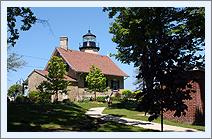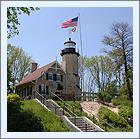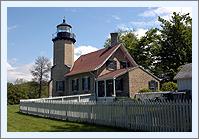|
Historical
Information

In the early 1800's western
Michigan consisted of seemingly endless forests, and with the
skyrocketing industrialization of the major cities in the Midwest, it
was inevitable that there would be those who would come to the area to
take advantage of its bounty. In 1838, Charles Mears built the
first sawmill on the shores of White Lake, and in 1849, the Reverend William
Ferry and his son Thomas purchased land around Stoney Creek where they
built a water-powered sawmill. The Ferrys also purchased land on the
shores of White Lake and built a steam powered mill at the mouth of the
White River, which joined White Lake to Lake Michigan.
While some of the lumber from these
mills was used for construction in the area, the vast majority ended up
being shipped to the growing cities of Chicago and Milwaukee on the
Lake's southern shores. As a result, increasing numbers of vessels began
tying-up at White River to be loaded with the area's bounty.
With a growing frequency of wrecks in
the area, the Michigan Legislature officially approached Congress
requesting a lighthouse at the entrance to White Lake on Jan 19, 1853.
While the lighthouse was undeniably necessary, for obvious reasons the
lumber barons and merchants of White Lake felt that the
creation of a new channel from White Lake into Lake Michigan was of even
more importance. Thus they too began lobbying the State and Federal
Governments to commence such an undertaking as quickly as possible.
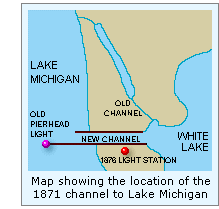 In 1866, the pressure being applied by
the Michiganders was felt, and Congress appropriated $67,000 for the
construction of a new channel between White Lake and Lake Michigan, and
$10,000 for the construction of a lighthouse at the harbor entry.
However, it was realized that the final outcome of the channel project
would have a significant impact on the location and construction of the
lighthouse. Thus the caveat was added, "…no expenditure shall be
made upon the aforesaid works until a careful survey shall have been
made, and the character of the structure required shall have been thus
determined. In 1866, the pressure being applied by
the Michiganders was felt, and Congress appropriated $67,000 for the
construction of a new channel between White Lake and Lake Michigan, and
$10,000 for the construction of a lighthouse at the harbor entry.
However, it was realized that the final outcome of the channel project
would have a significant impact on the location and construction of the
lighthouse. Thus the caveat was added, "…no expenditure shall be
made upon the aforesaid works until a careful survey shall have been
made, and the character of the structure required shall have been thus
determined.
Work
on the new channel began the following year and progressed slowly. In
1869, Congress appropriated an additional $45,000 to cover cost
overruns. After four years, the channel project was completed in 1871.
$1,059 of the lighthouse appropriation was spent on the construction of
a beacon at the end of the short south pier guarding the channel. The
square white pyramidal tower was of wooden construction, and stood 27
feet in height. The iron lantern room was prefabricated, and outfitted
with a Fifth Order Fresnel lens. With a focal plane of thirty-three
feet, the fixed red light was visible for approximately eleven and a
half miles at sea. With the construction of a small oil storage building
to house the tin containers of lard oil used to fuel the lamp, the White
River station was complete
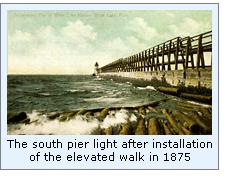 William Robinson became the first
keeper of the beacon light in 1872, and that same year the Lighthouse
Board requested that the sum of $4,000 be appropriated for the
construction of a keeper's dwelling on the shore near the pierhead
light. With no positive response to the request for a keeper's dwelling,
and significant growth in vessel passages into White Lake, the following
year the Lighthouse Board recommended to Congress that the appropriation
be increased to $15,000 to allow for the construction of a larger
shore-based light station. Congress finally reacted favorably, and a
survey of the area was conducted and land was obtained for the new
lighthouse in 1874. William Robinson became the first
keeper of the beacon light in 1872, and that same year the Lighthouse
Board requested that the sum of $4,000 be appropriated for the
construction of a keeper's dwelling on the shore near the pierhead
light. With no positive response to the request for a keeper's dwelling,
and significant growth in vessel passages into White Lake, the following
year the Lighthouse Board recommended to Congress that the appropriation
be increased to $15,000 to allow for the construction of a larger
shore-based light station. Congress finally reacted favorably, and a
survey of the area was conducted and land was obtained for the new
lighthouse in 1874.
1875 was a busy year at the White River
entrance. In August, a Lighthouse Service crew and a local contractor
began construction of an elevated wooden catwalk to the pierhead light,
and Keeper Robinson was instructed to employ five men to assist
Lighthouse Service construction Foreman E. Rhodes in the construction of
the new shore-based station. Grading was completed on September 28, and
construction of the building began with Keeper Robinson helping-out with
all phases of construction including the masonry work.
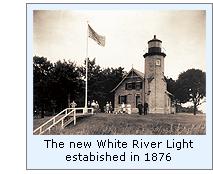 The foundation was laid from native limestone blocks, and the walls constructed of yellow Michigan brick.
The spiral cast iron stairs were manufactured in Muskegon, and the cast
iron lantern room was prefabricated at the Milwaukee lighthouse Depot,
and delivered by lighthouse tender. The crews working on the new catwalk
finished their job in November, and work continued on the new lighthouse
until December 28, when Rhodes and his team left the site for the
season.
At this point, all external structural work was complete on the
building, with only interior work and the installation of a light in the
empty lantern room remaining. The building featured a full cellar, with
an oil storage room accessible from the spiral staircase, which lead
from the cellar to the tower. The foundation was laid from native limestone blocks, and the walls constructed of yellow Michigan brick.
The spiral cast iron stairs were manufactured in Muskegon, and the cast
iron lantern room was prefabricated at the Milwaukee lighthouse Depot,
and delivered by lighthouse tender. The crews working on the new catwalk
finished their job in November, and work continued on the new lighthouse
until December 28, when Rhodes and his team left the site for the
season.
At this point, all external structural work was complete on the
building, with only interior work and the installation of a light in the
empty lantern room remaining. The building featured a full cellar, with
an oil storage room accessible from the spiral staircase, which lead
from the cellar to the tower.
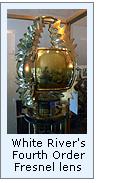 The Lighthouse Service Lampist arrived
to install the Fourth Order Fresnel lens and lamp in April of 1876, and
Keeper Robinson exhibited the new light for the first time on May 31st .
The lens rotated at a speed of one half a revolution per minute, and
showed as a fixed white light varied by a flash one a minute. Robinson
continued the task of finishing-out the inside of the dwelling through
the remainder of the year. The south pier was also extended by a hundred
feet during this same year. The beacon was lifted and moved to the new
pier end, and the wooden catwalk was extended to the new beacon
location. Additionally, two hundred and twenty six feet of the existing
catwalk was repaired. The Lighthouse Service Lampist arrived
to install the Fourth Order Fresnel lens and lamp in April of 1876, and
Keeper Robinson exhibited the new light for the first time on May 31st .
The lens rotated at a speed of one half a revolution per minute, and
showed as a fixed white light varied by a flash one a minute. Robinson
continued the task of finishing-out the inside of the dwelling through
the remainder of the year. The south pier was also extended by a hundred
feet during this same year. The beacon was lifted and moved to the new
pier end, and the wooden catwalk was extended to the new beacon
location. Additionally, two hundred and twenty six feet of the existing
catwalk was repaired.
With two lights now guarding the
entrance to the White River, one would assume that shipwrecks had become
all but non-existent. Unfortunately this was not the case, and a number
of vessels ran aground in the area over the ensuing years. The
Lighthouse Service assumed that the nature of the light signature was to
blame. On November 1, 1890, the Lighthouse Service Lampist arrived at
the White River Light Station and took measurements of the original
Fresnel lens and flash panels in order to fabricate new frames and order
parts from France. After notifying mariners of the impending change, the
light was modified on December 12 of 1892. Thus the character of the
light was changed to a steady white light, varied by a red flash every
forty seconds.
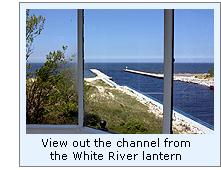 The results of the light modification
must not have achieved the desired results, as the Lampist again arrived
at White River on November 8, 1901 and increased its rotation speed to
one revolution every forty seconds. In order to achieve this speed
increase, ball bearings were installed in the carriage wheels on which
the lens rotated. With this modification, the characteristic was changed
to alternating red and white flashes with twenty seconds intervals
between. After this modification the light was visible for a distance of
fourteen miles at sea. Also in 1901, part of the wooden catwalk on the
pier was replaced with an iron assembly. The results of the light modification
must not have achieved the desired results, as the Lampist again arrived
at White River on November 8, 1901 and increased its rotation speed to
one revolution every forty seconds. In order to achieve this speed
increase, ball bearings were installed in the carriage wheels on which
the lens rotated. With this modification, the characteristic was changed
to alternating red and white flashes with twenty seconds intervals
between. After this modification the light was visible for a distance of
fourteen miles at sea. Also in 1901, part of the wooden catwalk on the
pier was replaced with an iron assembly.
In 1902 the Pierhead Light Fresnel was
removed, and replaced with a smaller
sixth order lens, reducing its
visibility to nine miles. Things remained relatively stable at White
River for the next nine years until a crew arrived in 1910 to convert
the entire Pierhead catwalk to cast iron.
The Lighthouse Service was still
dissatisfied with the characteristics of the light in the shore-based
station, and in February of 1912 the Keeper received instructions to
disassemble the lens and clockwork assembly and ship them to the
Milwaukee Depot. At the Depot, the red flash panels were removed, and
when reinstalled the light's characteristic was changed to a cycle of a
white flash of ten-second duration followed by darkness for ten seconds.
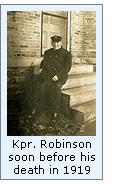 As was becoming the practice during
this period on the Great Lakes, the Pierhead light was painted red in
1917. The following year a jute covered electrical cable was run across
the bottom of the channel from the north shore and a 9.600 candlepower
incandescent light bulb was installed in the light station tower. Keeper
Robinson passed away at 10.10 AM on April 2, 1919, after faithfully
tending the White River light for 47 years. At 87 years of age, he was
the oldest active keeper in service at the time of his death. As was becoming the practice during
this period on the Great Lakes, the Pierhead light was painted red in
1917. The following year a jute covered electrical cable was run across
the bottom of the channel from the north shore and a 9.600 candlepower
incandescent light bulb was installed in the light station tower. Keeper
Robinson passed away at 10.10 AM on April 2, 1919, after faithfully
tending the White River light for 47 years. At 87 years of age, he was
the oldest active keeper in service at the time of his death.
While the pierhead light had thus been electrified in
1917, the main light and dwelling would not be electrified until
1924, when electrical power finally made its way around the south shore
of White Lake.
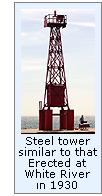 Ever since its original installation,
the Pierhead Light catwalk had been plagued constant maintenance
requirements resulting from vessels making contact while passing through
the channel. Exasperated with the cost of constant annual maintenance,
the catwalk was completely removed in May 1925, and the components were
shipped to the Milwaukee Depot for possible use elsewhere. Ever since its original installation,
the Pierhead Light catwalk had been plagued constant maintenance
requirements resulting from vessels making contact while passing through
the channel. Exasperated with the cost of constant annual maintenance,
the catwalk was completely removed in May 1925, and the components were
shipped to the Milwaukee Depot for possible use elsewhere.
Finally the end came for the old
Pierhead Light in 1930, when the pier was completely refaced with
concrete, and the wooden tower replaced by a skeletal steel structure.
The Lighthouse Tender Hyacinth arrived in November and took the lantern,
lens and other reusable components back to the Lighthouse Depot in
Milwaukee. The new tower was equipped with an acetylene lamp controlled
by a sun valve. This sun valve was a source of constant trouble until
the light was electrified in 1949.
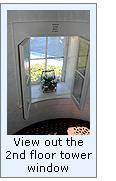 The shore-based light station was
decommissioned in 1960, and the Fresnel removed, crated and shipped to
the Detroit Coast Guard Depot. Fruitland Township purchased the
structure in 1966, with plans of converting it into a maritime museum.
The museum was opened for the first time in the summer of 1970. In 1972
the Coast Guard returned the Fresnel lens to the museum, where it was
reinstalled in the lantern room. The lens stood proudly in the tower
until 1975 when someone with a rifle and little intelligence shot
through the lantern room windows, chipping the irreplaceable lens. To
prevent a reoccurrence, the lamp was once again removed from the tower,
and redisplayed on the first floor of the museum, where it can be seen
to this day. The shore-based light station was
decommissioned in 1960, and the Fresnel removed, crated and shipped to
the Detroit Coast Guard Depot. Fruitland Township purchased the
structure in 1966, with plans of converting it into a maritime museum.
The museum was opened for the first time in the summer of 1970. In 1972
the Coast Guard returned the Fresnel lens to the museum, where it was
reinstalled in the lantern room. The lens stood proudly in the tower
until 1975 when someone with a rifle and little intelligence shot
through the lantern room windows, chipping the irreplaceable lens. To
prevent a reoccurrence, the lamp was once again removed from the tower,
and redisplayed on the first floor of the museum, where it can be seen
to this day.
At some time during the 1980's, the
skeletal steel tower installed in 1930 was demolished and replaced with
a simple steel pole with a triangular red daymark at its top, along with
a flashing red electric light. Thus, while no where near as romantic, a
light still faithfully guides vessels into the White River, as it has
since 1871.

Keeper of this Light

Click Here to see a complete listing of
all White River Light keepers compiled by Phyllis L. Tag of Great Lakes
Lighthouse Research.

Finding this
Light

Take White Lake Drive west for approximately 5 miles from US31. Turn
South on South Shore and go approximately 3 1/2 miles. Head West on
Lakewood Street. Continue through the 4 way stop, and the road changes
to Murray Road. Look for the Lighthouse Museum sign, and follow the
narrow road up to the lighthouse.
Thomas A. Tag has an
written an excellent book covering the history of the White River
lighthouse in detail. Click
here
to visit Tom's web site, and find out how to purchase a copy of
his book.

Reference
Sources

Lighthouse Board annual
reports, various, 1867 -1920
Lake Carriers Association annual reports, 1938 & 1939
White River Light Light Station, Thomas A. Tag, 1996
Photographs from author's personal collection.
Personal observation at White River, 09/13/1998 & 6/2/2004
Keeper listings for this light appear courtesy of
Great
Lakes Lighthouse Research
|
